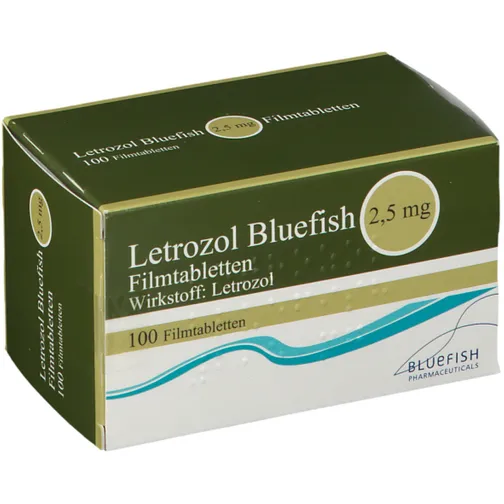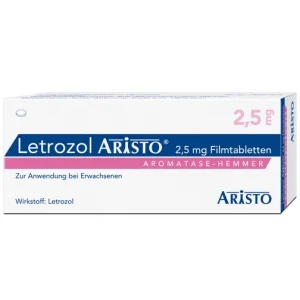Description
Letrozole is a competitive non-steroidal aromatase inhibitor. Aromatase is an enzyme that ensures the conversion of androgens (synthesised in the adrenal glands) to oestrone and oestradiol in postmenopausal women. Given that, in some cases, the growth of tumour tissues depends on the presence of oestrogens, which in the postmenopausal period are mainly formed only with the involvement of aromatase, the use of aromatase inhibitors makes it possible to reduce oestrogen levels and create the conditions for a tumour response to therapy.
In animal experiments, the use of letrozole led to a reduction in uterine weight and regression of (hormone-dependent) tumours with efficacy similar to ovariectomy. At the same time, against the background of letrozole therapy (in contrast to ovariectomy), there is no increase in serum folliculotropic hormone levels.
Letrozole selectively inhibits steroid production in the gonads without affecting the production of glucocorticosteroids and mineralocorticosteroids in the adrenal glands.
The mechanism of aromatase inhibition is realised through letrozole’s cometic binding to haem cytochrome P450, resulting in a decrease in the biosynthesis of oestradiol in all tissues of the body.
Against the background of letrozole treatment, there is a reduction in serum concentrations of oestradiol, oestrone and oestrone sulphate without significant effects on aldosterone and corticoid synthesis, as well as thyroid hormones.
Letrozole is absorbed quite rapidly in the gastrointestinal tract. Bioavailability reaches 99.9%, with food slightly decreasing the rate of absorption without significantly affecting the time to peak concentration.
Approximately 60% of letrozole in serum is in the bound state (mainly with albumin). The level of letrozole in leukocytes reaches 80% of the plasma concentration.
Letrozole is metabolised to a minor extent (approximately 82% of the labelled letrozole in serum was unchanged); letrozole derivatives have no therapeutic activity. Metabolism is mediated by P450 isoenzymes
Letrozole is well distributed in tissues, with a volume of distribution of 1.87 ± 0.47 l/kg.
Letrozole is excreted via the kidneys. The elimination phase half-life is 2 days; equilibrium concentrations at sustained therapeutic doses are observed after 2-6 weeks of treatment (equilibrium concentrations are approximately 7 times higher than those obtained after a single administration of letrozole). However, equilibrium concentrations are 1.5-2 times higher than the expected equilibrium concentrations that can be calculated taking into account concentrations after a single administration (indicating a deviation from linear pharmacokinetics).
Letrozole does not accumulate in the body (given the long time at equilibrium concentrations).
Indications for use
- Letrozole is used in postmenopausal women in the early stages of oestrogen-dependent breast cancer (as adjuvant therapy).
- The drug is used for prolonged adjuvant treatment in postmenopausal women in the early stages of breast cancer (after standard adjuvant treatment with tamoxifen).
- Letrozole is used as first-line treatment for localised or metastatic breast cancer (hormone receptor-positive) in postmenopausal women, and where the presence of hormone receptor positivity is unknown.
- The drug can be used for the treatment of postmenopausal women (whether menopause was natural or artificially induced) with advanced breast cancer in cases where disease progression has been noted after previous treatment with anti-estrogens.






Reviews
There are no reviews yet.